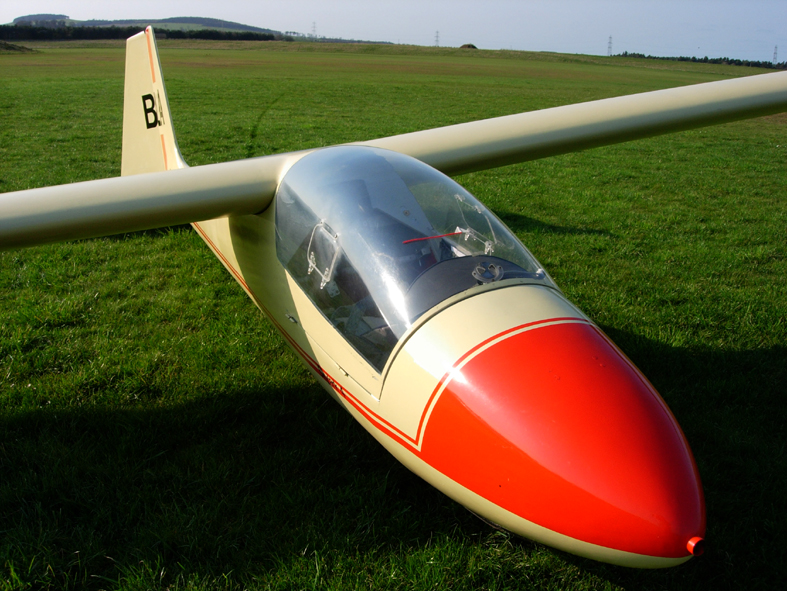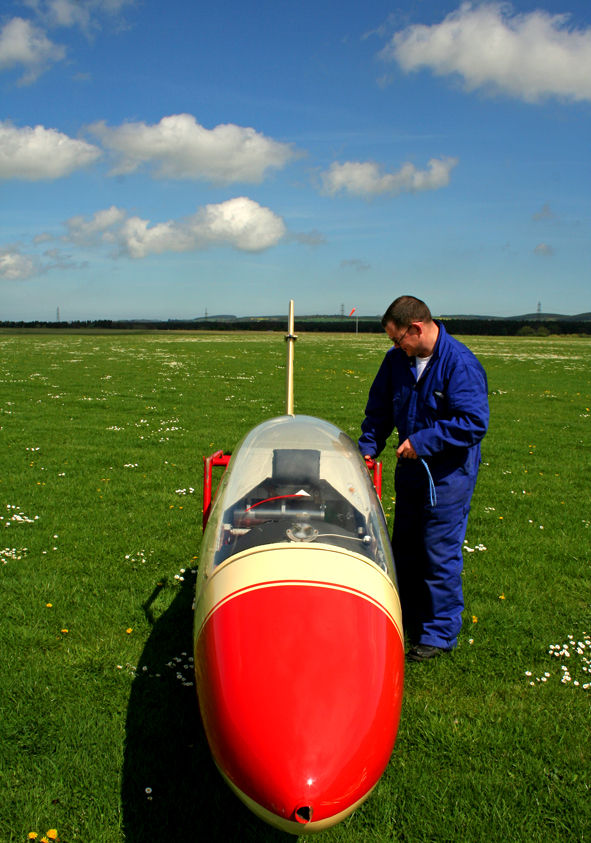Slingsby Skylark 4 on:
[Wikipedia]
[Google]
[Amazon]
The Slingsby T.50 Skylark 4 was a British single seat competition glider built by Slingsby Sailplanes in the early 1960s. It sold in numbers and had success at national, though not world level competition.
 Behind the cockpit the fuselage is a semi-monocoque, elliptical in cross section and built around spruce frames with a plywood skin. The fuselage line no longer fell away rapidly behind the trailing edge, but continued straight to the tail, where tapered and clipped tailplane and elevators were mounted on top, far enough forward that the rudder hinge was behind the elevators. These surfaces were plywood covered. Fin and rudder together are tapered and flat topped; the fin is also ply-skinned, but the unbalanced rudder is fabric covered.
Behind the cockpit the fuselage is a semi-monocoque, elliptical in cross section and built around spruce frames with a plywood skin. The fuselage line no longer fell away rapidly behind the trailing edge, but continued straight to the tail, where tapered and clipped tailplane and elevators were mounted on top, far enough forward that the rudder hinge was behind the elevators. These surfaces were plywood covered. Fin and rudder together are tapered and flat topped; the fin is also ply-skinned, but the unbalanced rudder is fabric covered.
 The undercarriage was conventional, with a nose skid, fixed monowheel and tail bumper. A simple-friction wheelbrake is applied to the mainwheel by pulling on the airbrake lever at the end of its furthest travel.
The cockpit is immediately ahead of the wing leading-edge, enclosed with a lengthened perspex canopy, and the Skylark 4 was 80 mm (4 in) longer than its predecessor.
The undercarriage was conventional, with a nose skid, fixed monowheel and tail bumper. A simple-friction wheelbrake is applied to the mainwheel by pulling on the airbrake lever at the end of its furthest travel.
The cockpit is immediately ahead of the wing leading-edge, enclosed with a lengthened perspex canopy, and the Skylark 4 was 80 mm (4 in) longer than its predecessor.
''Flight'' 4 June 1964 p.940
/ref>
Development
The Slingsby Skylark 4 is the final development of the Skylark series of gliders and was first manufactured in 1961 using an 18.2m span wing similar to that of the Skylark 3. About 30 Skylark 4s are still flying today (2010). Slingsby had introduced double curvature fuselage panels made ofglass reinforced plastic
Fiberglass (American English) or fibreglass (Commonwealth English) is a common type of fiber-reinforced plastic using glass fiber. The fibers may be randomly arranged, flattened into a sheet called a chopped strand mat, or woven into glass cl ...
(GRP) into their previous design, the T.49 Capstan and they remodelled the front of the wooden fuselage of the Skylark 3 in this material for the Skylark 4, introducing a reclining pilot's position and smoother canopy line. Though the previous wing planform, span and area was retained, its ailerons were extended to increase the rate of roll and the outer panels used a different airfoil section, the more cambered NACA 6415, to give a better lift distribution.
The Skylark 4 has a high wing with a single inner section of parallel chord extending out almost to mid span, followed by outer sections with taper on the trailing edges. Ailerons filled almost all of the outer sections and airbrakes, operating in pairs above and below the wings, are mounted on the main spar in the inboard section. The wing is wooden, built around a main spar of Spruce and a lighter rear spar and Gaboon ply covered from this rear spar forward. Behind this spar the wing was fabric covered, though the ailerons were ply skinned. The Gaboon ply was applied diagonally across the ribs, which produced a very smooth wing-surface that is claimed to generate a laminar airflow. This in turn gives a best-glide ratio of 1:36 which is comparable with early fibreglass gliders.
 Behind the cockpit the fuselage is a semi-monocoque, elliptical in cross section and built around spruce frames with a plywood skin. The fuselage line no longer fell away rapidly behind the trailing edge, but continued straight to the tail, where tapered and clipped tailplane and elevators were mounted on top, far enough forward that the rudder hinge was behind the elevators. These surfaces were plywood covered. Fin and rudder together are tapered and flat topped; the fin is also ply-skinned, but the unbalanced rudder is fabric covered.
Behind the cockpit the fuselage is a semi-monocoque, elliptical in cross section and built around spruce frames with a plywood skin. The fuselage line no longer fell away rapidly behind the trailing edge, but continued straight to the tail, where tapered and clipped tailplane and elevators were mounted on top, far enough forward that the rudder hinge was behind the elevators. These surfaces were plywood covered. Fin and rudder together are tapered and flat topped; the fin is also ply-skinned, but the unbalanced rudder is fabric covered.
 The undercarriage was conventional, with a nose skid, fixed monowheel and tail bumper. A simple-friction wheelbrake is applied to the mainwheel by pulling on the airbrake lever at the end of its furthest travel.
The cockpit is immediately ahead of the wing leading-edge, enclosed with a lengthened perspex canopy, and the Skylark 4 was 80 mm (4 in) longer than its predecessor.
The undercarriage was conventional, with a nose skid, fixed monowheel and tail bumper. A simple-friction wheelbrake is applied to the mainwheel by pulling on the airbrake lever at the end of its furthest travel.
The cockpit is immediately ahead of the wing leading-edge, enclosed with a lengthened perspex canopy, and the Skylark 4 was 80 mm (4 in) longer than its predecessor.
Operational history
The Skylark 4 first flew in February 1961. 62 complete aircraft were built by Slingsby atKirbymoorside
Kirkbymoorside () is a market town and civil parish in North Yorkshire, England. It is north of York; midway between Pickering and Helmsley, and on the edge of the North York Moors National Park. The parish had a population of 3,040 in the 20 ...
and another 3 were assembled by Fred Dunn in New Zealand
New Zealand () is an island country in the southwestern Pacific Ocean. It consists of two main landmasses—the North Island () and the South Island ()—and List of islands of New Zealand, over 600 smaller islands. It is the List of isla ...
from kits that Slingsby supplied. 19 of Slingsby's 62 were exported.
The Skylark 4 failed to get into the top positions in the World Gliding Championships
The World Gliding Championships (WGC) is a gliding competitions, gliding competition held roughly every two years by the FAI Gliding Commission. The dates are not always exactly two years apart, often because the contests are always held in the sum ...
of 1963 and 1965. In 1963, at Junin, Argentina
Argentina, officially the Argentine Republic, is a country in the southern half of South America. It covers an area of , making it the List of South American countries by area, second-largest country in South America after Brazil, the fourt ...
the four Skylark 4s of the British team were placed consecutively 8-11th, and a single entry came 9th in 1965 at South Cerney
South Cerney is a village and civil parish in the Cotswold district of Gloucestershire, 3 miles south of Cirencester and close to the border with Wiltshire.
It had a population of 3,074 according to the 2001 census, increasing to 3,464 at the ...
, UK. It performed better at the national level; Dick Johnson flew one into first place in the US National Gliding Championships in both 1963 and 1964. A Skylark 4 came second (to a Skylark 3) in the British Nationals at Lasham
Lasham is a village and civil parish in the East Hampshire district of Hampshire, England. It is northwest of Alton, Hampshire, Alton and north of Bentworth, just off the A339 road. The parish covers an area of and has an average elevation o ...
in 1964./ref>
Specifications
See also
Notes
References
* '* {{Slingsby aircraft 1960s British sailplanes Skylark 4 Aircraft first flown in 1961 High-wing aircraft